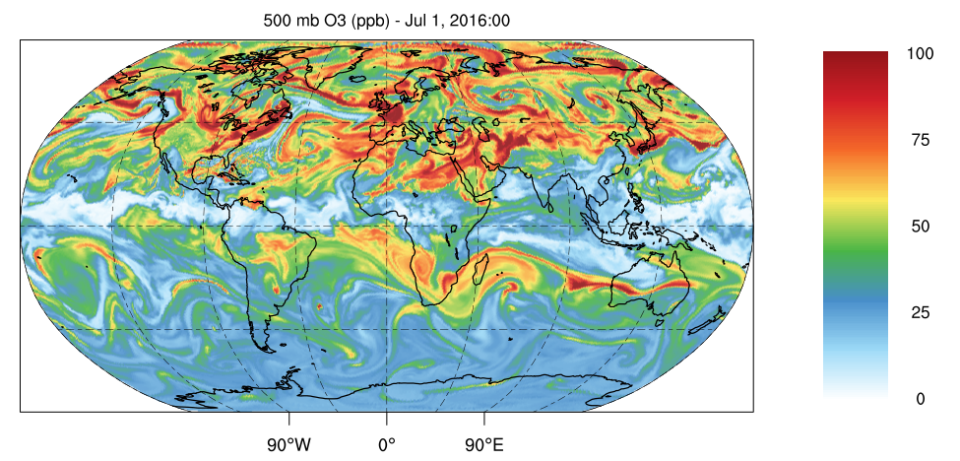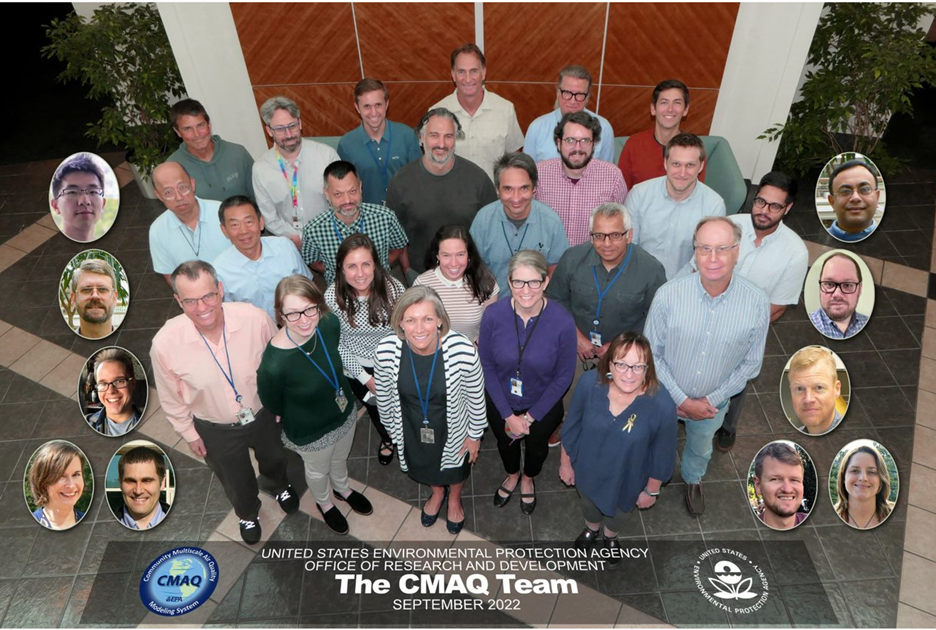CMAQ: Tackling Emerging Concerns and Building for the Future
Published June 21, 2023

This year, EPA proudly celebrates the 25th anniversary of EPA’s Community Multiscale Air Quality (CMAQ) modeling system, which was initially released June 30, 1998. In the final installment of this series, we’ll share how CMAQ has continued to innovate, modernize, and address emerging environmental issues.
Quantifying Interactions between Climate, Air Quality, and Human Health
In the late 2000s, CMAQ was instrumental in advancing important research on regional climate and air quality interactions. Using regional climate information, CMAQ was used in one of the first studies to quantify the respective contributions of climate change and emissions changes to projected air quality. With improvements to modeling techniques and advances in computational power, CMAQ was later used to simulate full decades of air quality projections that could be used to explore changes to air quality and health under various future conditions.
“These air quality simulations have informed assessments of the myriad health and economic impacts of climate change under EPA’s Climate Change Impacts and Risk Analysis (CIRA) project,” remarked Chris Nolte, EPA research physical scientist and Federal Coordinating Lead Author and Chapter Lead of the inaugural chapter on air quality in the Fourth National Climate Assessment, where air quality projections from CMAQ were also featured.
Atmospheric Toxics and Pollutants of Concern
As new atmospheric toxics and pollutants of concern emerged, CMAQ has been updated with extensions for simulating the movement of those pollutants through the atmosphere. Some pollutants gained urgency after their threats to human health were better understood by using tools like CMAQ. “Air toxics are classified under a separate category called hazardous air pollutants. Their health impacts are chronic or cumulative, and criteria air pollutants generally have acute or short-term health impacts,” said Bill Hutzell, an EPA research physical scientist who has been with the CMAQ team for nearly 25 years.
More recently, a suite of chemical reactions was introduced in CMAQ to quantify the movement and distribution of per- and polyfluoroalkyl substances (PFAS, or “forever chemicals”) through air to characterize their impacts on human health through direct inhalation and depositing to land and water. Ben Murphy, EPA research physical scientist, explained, “CMAQ has helped us go back in time to better understand what likely happened to PFAS compounds emitted into the air from chemical factories. For example, we have been able to determine that the elevated concentrations of PFAS measured in rainwater near a manufacturing facility were only a minor fraction of the total emitted, and greater than 95% of the emissions traveled more than 150 kilometers from the facility.”
EQUATES: A True One Environment–One Health Database
EPA’s Air Quality Time Series (EQUATES) database was developed using CMAQ to provide a comprehensive, unified evolution of meteorology, emissions, air quality, and pollutant deposition for the most recent two decades. Initially built to explore changes in total maximum daily loads of pollutants to ecosystems, EQUATES emerged as a powerful data source that is built on the “one environment–one health” concept. In particular, the detailed emissions data were constructed through strong coordination between EPA’s science and regulatory experts.
“This large team effort resulted in a long-term emissions record that is better designed for trends analysis than previous emissions inventories. Using these improved emissions as inputs to the CMAQ model, we are able to quantify the improvement in air quality in our communities due to past emissions reduction measures and use this to inform potential future actions,” noted Kristen Foley, EPA research statistician and EQUATES principal investigator. EQUATES can be used to explore critical loads and nutrient assessments, for epidemiological studies, for trends analysis, and for CMAQ model evaluation.
Managing the Software and Moving it Forward
The science in the CMAQ system has become increasingly sophisticated as its community has grown with a footprint on six continents. For the past ten years, partners at the CMAS Center at the University of North Carolina at Chapel Hill have maintained an online user forum to facilitate individual assistance and communication of issues that arise in different applications of CMAQ. The forum provides a direct connection between the user community and the developers, plus a searchable documentation of past problems and solutions, which limits the time spent addressing repeat user issues. The recurrence of issues reported through the forum also prompts places where corrections could be made to CMAQ and identifies any needs for additional documentation. In another modernizing move, the CMAQ team launched a software repository on GitHub for public releases in 2017, along with a private development space to propose and document changes to the modeling system that could be considered for a future public release.
CMAQ is typically run on a traditional high-performance computing platform, but research is underway toward an option to use CMAQ in a cloud computing environment. A cloud computing option for CMAQ would make the system more accessible to smaller modeling groups that lack the budget and infrastructure to support a private computing system. EPA Research physical scientist Fahim Sidi is leading this effort and elaborated, “With the emergence of cloud technologies, stakeholders can now commercially rent supercomputers to understand air quality management from a numerical modeling perspective. For example, preconfigured CMAQ ready machines are available via commercial cloud service providers to allow users to hit the ground running without the steep learning curve and financial burdens of software infrastructure.” This capability expands the versatility and utility of CMAQ for new stakeholder groups.

The Evolution Continues
CMAQ continues to be updated with new science and maintains international prominence in air quality modeling. Longer-term development efforts in CMAQ are proposed to meet emerging and anticipated EPA needs. Alan Vette, Director of EPA’s Atmospheric & Environmental Systems Modeling Division which conducts CMAQ development, emphasized, “The science of air pollution is constantly evolving, as does EPA’s efforts to reduce impacts from air pollution. It’s vital that we develop an agile and nimble model that provides insights and anticipates needs so EPA can protect your health and the environment we all enjoy.”
For example, EPA scientists are leading the development of a new chemical mechanism for CMAQ, called the Community Regional Atmospheric Chemistry Multiphase Mechanism (CRACMM). CRACMM facilitates scientific updates that reflect emerging emphases on newer classes of atmospheric pollutants and streamlines maintenance activities in CMAQ.
Havala Pye, EPA research physical scientist and scientific lead for the development of CRACMM, described, “CRACMM uses the best chemistry information from universities and government partners to describe complex atmospheric transformations. One of the ways CMAQ is using CRACMM is to predict the generation of novel pollutants from wildfires and better understand the impact of fires on human health.” The development of CRACMM is on a multi-year timeline that will continue to include contributions from world-renowned scientists at EPA and beyond.
In addition, the development of the Advanced Air Quality Modeling System (AAQMS) is underway at EPA. This system allows CMAQ to operate on a global scale with science that allows changes in atmospheric chemistry to affect the presence of clouds and the resultant weather conditions. This ambitious approach with AAQMS will more comprehensively consider the influence of global emissions and weather on local air quality in the U.S. “Since air pollution has no boundaries, our models should also have no boundaries. The AAQMS covers the entire globe with capability to zoom in on local areas,” said Jon Pleim, EPA research physical scientist leading the AAQMS development.
Using the initial development principles (extensible, modular, one-atmosphere), CMAQ has endured. The evolving science in CMAQ continues to be rigorously evaluated through peer reviewed publications, open-source model code, and external scientific panels convened on a regular basis, ensuring that sound science guides regulatory assessments supported by the modeling system.
“For 25 years, CMAQ has provided a state-of-the-science, respected, and defensible platform for EPA to support its air regulations and demonstrate their benefits, help states to understand which sources are contributing to poor air quality, and provide improved understanding of atmospheric deposition to critical ecosystems such as the Chesapeake Bay,” lauded Bryan Hubbell, Director of EPA’s Air, Climate, and Energy National Research Program. “Continued advancements in CMAQ are helping to identify where future air quality may be impacted by climate change and incorporating emerging contaminants like PFAS will help EPA and state partners make plans to protect air quality for future generations.”
After a quarter century, CMAQ remains a vital tool in EPA’s regulatory and research collection. Moving forward, CMAQ is poised to address EPA’s air quality challenges for many years to come.

Read more stories about CMAQ:
- CMAQ: Celebrating 25 Years of Air Quality Modeling Excellence
- CMAQ: Demonstrating Skill Across Media and Around the World
Follow @EPAresearch on Twitter throughout 2023 as we highlight some of the accomplishments, milestones, and notable elements from CMAQ’s 25-year history, and search for #CMAQ25th.
This series was written by Tanya Spero, a research physical scientist in EPA’s Office of Research and Development. She joined the CMAQ Team just prior to the initial release of the model in 1998, and she remains active on the team today.
